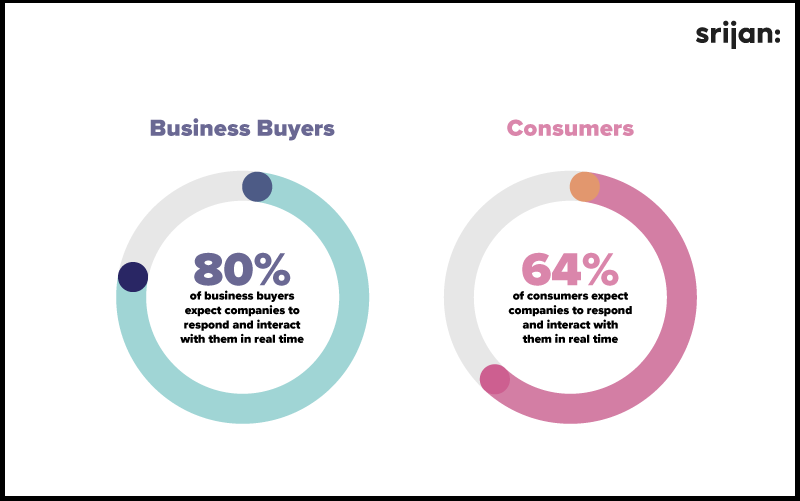Customers interact with brands via multiple mediums on a daily basis. However, the information collected by the brands, an important part of defining user journey, can remain in silos, fragmented or disjointed on different platforms.
Finding this collection of data, which remains extremely valuable to marketers, at a centralized place is beyond the realms of their fantasy.
New marketing-focused, data management tools have emerged to address the issues of multi-channel data integration, colloquially known as Customer Data Platform (CDP).
The Need for a Unified Customer Experience
According to a 2016 study by Experian, 81% of marketers report challenges in achieving a single, unified customer view.
Several emerging MarTech tools work to achieve this customer profile view, including social media listening tools, CRM softwares, voice of the customer (feedback) programs, web analytics, and marketing automation tools. However, they don’t solve the purpose as they bring with them new data which needs to be combined, cleaned and made accessible to marketing and business leaders again.
Customer Data Platform helps bring all the data across channels together.
Focusing on 360-Degree customer view can help brands and enterprises to aggregate customer data across all their touchpoints and create a unified customer profile. This ensures data-driven, customer-centric marketing campaigns for a unified customer experience across the entire lifecycle of the customer journey.
Understanding CDP and how it Impacts Customer Experiences
A CDP unifies customer data and lets companies build CX programmes faster and at a lower incremental cost.
According to David Raab, the founder of the CDP Institute, the customer data platform is fast becoming a central requirement for those brands wishing to meet the data achievements of brands like Tesla.
This extracted information from a variety of sources is essentially important for marketers to build a better and a clearer picture of what the customer wants in order to be able to market effectively. It helps them to make informed decisions to deliver the best customer experience, increasing the possibility of converting lead to a customer.
A CDP can be thought of as a data hub (and not database or repository or data storage or your CRM database) that allows all your customer data from multiple sources and channels to be exposed, aggregated, consistently formatted, and directed to a specific task.
However, before making use of customer’s data, their consent is essentially needed which should be considered as part of building trust. Once that trust is built, the customer-centric personalization tools work to deliver more relevant experiences, leading to better conversions and sales. With legal concerns, ensuring your company is compliant with new EU GDPR and California data privacy regulations should be a top priority when you think about dealing with your customers’ information.
CDP works on:
- Gathering information on user actions during an event on a website, in an app, or on a mobile browser
- Storing names, addresses, contact details, birthdays, etc. so as to make machine-learning powered predictions
- Maintaining a record of purchases, returns, and other info and other interactions on e-commerce platforms
- Gauging engagement, reach, impressions, and other metrics from marketing campaigns.
- Collecting information from customer service data from live chats, frequency of interactions, NPS scores and other data from CRM systems.
According to a 2018 Digital Trends report, 77% of companies in North America see optimizing their customer journey across multiple touchpoints over the next few years as one of their top priorities.
Affecting customer experience
- Tracking Customer Journey – Post analyzing customer data across different touchpoints, CDP facilitates greater personalization to analyze and optimize an engaging customer journey across every step they take.
- Personalizing Experiences – CDP provides marketers with accurate and detailed customer profiles through the collection and unification of information from a range of data silos such as CRM systems, emails, and websites. Personalized emails or text messages with a targeted message appeals to the customer as an individual, and gets their attention and appeal to them and result in a conversion.
- Real-Time Results– Marketers spend a lot of time preparing data to identify trends and create a tailored campaign, which usually results in a lost opportunity. CDP offers personalization at real-time to help build customer relationships and generate sales at the critical moment by providing them with relevant content and offers at the right time by knowing who they are and what they want. As per Salesforce 2017 research, 64% of consumers now expect companies to interact with them without delay.

Also, the research highlights that consumers are increasingly expecting consistent and unified experiences with brands.
“A unified experience means that customers are treated consistently across all channels and that each experience is tailored to the customer’s personal situation,” says David Raab.
You could treat all customers exactly the same across all channels by treating them right and through consistent training, without using any customer data at all.
However, providing a memorable customer experience, that too tailored to their situation strikes the right chord with them, and which is only possible if you have their data. This experience has to be consistent across channels, and not limited to one, which means all the channels which the customer interacts with should sync with CDP and apply the same decision rules.
Freshly, a food delivery start-up, implemented CDP for its marketing team to identify the customer personas within the database, predicting their product preferences, spend levels, customer future value as per their past behaviour and then automated the delivery of most-relevant messaging to them. It led to a 64% increase in its average order value.
The market for customer data platforms (CDPs) is growing rapidly. CDP Institute estimates, by the end of 2019, the market will exceed $1 billion in revenue. This growth is largely due to increasing need of organizations to provide improved customer experiences by providing personalized, multichannel experiences.
Acquia Recently Acquired AgilOne
Recently, Acquia acquired AgilOne, a leading CDP startup. The machine learning capabilities of AgilOne made it the best choice amongst its competitors. It is capable of intelligently segmenting customers and predicting their behaviors to deliver a competitive advantage. This allows for creating and optimizing offers and messages to customers on a one-on-one basis and empowers its marketers to identify their customers and create omnichannel experiences to enhance their engagement.
AgilOne has helped Lululemon, one of the most popular brands in workout apparel, in integrating all the systems into a unified customer data profiles after collecting data across a variety of online and offline interactions (in-store events and website interactions, e-commerce transactions, email marketing, and more). With its machine learning capabilities, it increased Lululemon’s attendance to local events by 25%, increased revenue from digital marketing campaigns by 10-15%, and boosted site visits by 50%.
What Makes a CDP Different from regular Data Management Platforms and CRMs?
Managing customer data is not a new trend and the hunt for the best tool had never stopped. With modern tools, the pace of progress has increased manifolds, allowing for more and more useful tools.
Online customer relationship management (CRM) software was introduced in the 90’s, and allowed enterprises to keep record of their interactions with both current and potential customers at one place. Being able to perform data analysis, they also helped drive retention and sales. However, they worked only for registered clients and made use of only predefined first party data.
Data Management Platforms (DMPs) changed how things were implemented in the 2000’s. DMPs helped with the planning and execution of media campaigns and worked with second- and third-party data, and could also segment anonymous IDs.
Customer Data Platform (CDP) was introduced in 2016 for an improved customer experience and omni-channel marketing initiatives as marketers weren’t able to productively use all the data the company had access to.
Here’s a table to understand the distinctions for you to choose the right product for your business needs.
|
Metrics |
CDP |
DMP |
CRM |
|
Holistic Customer Data (customer data from all available sources - behavioral, demographic, personal, transactional, device, etc) |
Yes |
No |
No |
|
Lasting Customer Profiles (retention of customer data for a long period of time) |
Yes |
No |
Yes |
|
Packaged System (system being used as a ready-to-use piece of software) |
Yes |
Yes |
Yes |
|
Real-time Capability (ability to update data in real-time) |
Yes |
Yes |
No |
|
Open Platform (how simple is it to get data into the platform and to share it with other services) |
Yes |
Yes |
No |
|
Cross-channel Personalization (allowing personalization of messages across different customer touchpoints) |
Yes |
No |
No |
|
Only Anonymized Data (work with unidentified customers to allow for granularized views of individual customers) |
No |
Yes |
No |
|
Identity Resolution (if the platform allows you to connect the behavior of anonymous visitors with known customers post their consent) |
Yes |
No |
No |
|
Data priority: First Party (referring to platform’s primarily deal with data from 1st party sources) |
Yes |
No |
Yes |
|
Data priority: Third Party (referring to platform’s primarily deal with data from 3rd party sources) |
No |
Yes |
No |
|
Requires IT Support (referring to the need for IT help needed) |
Yes |
Yes |
Yes |
Final Words
With MarTech proliferation in every conceivable category, across multiple channels, the volume of unstructured and structured data is increasing on a daily basis, and the need for a unified data management solution has become more and more necessary. CDPs are quickly emerging, and are becoming more and more critical for companies who are serious about pursuing customer-centric marketing and business strategies. Opt for CDP for your enterprise to build customer-centric personalization campaigns so as to increase their value towards your customers.
Our Services
Customer Experience Management
- Content Management
- Marketing Automation
- Mobile Application Development
- Drupal Support and Maintanence
Enterprise Modernization, Platforms & Cloud
- Modernization Strategy
- API Management & Developer Portals
- Hybrid Cloud & Cloud Native Platforms
- Site Reliability Engineering



